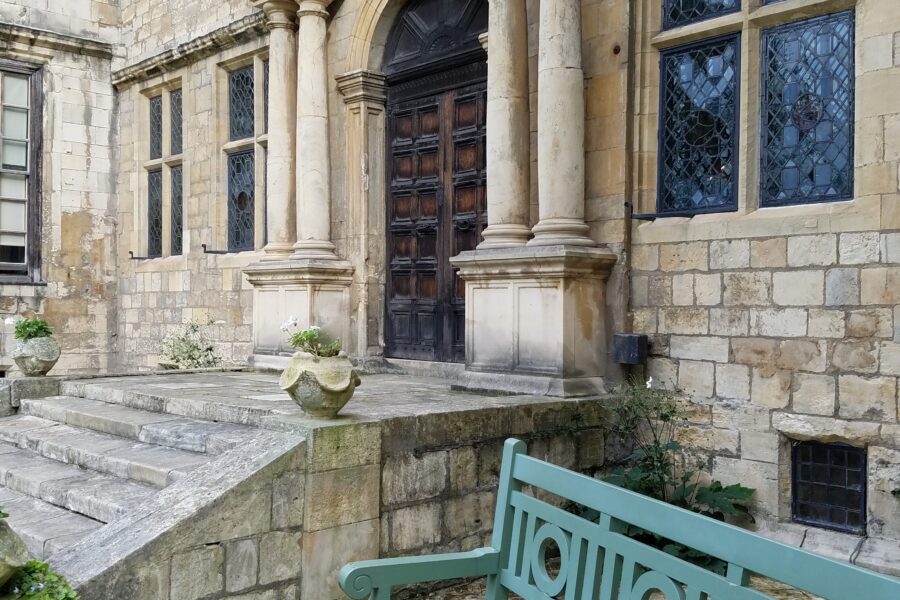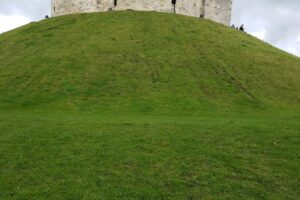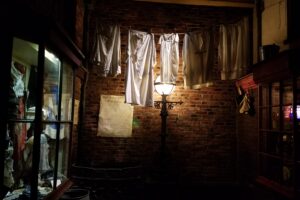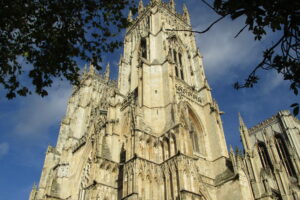Walking through the wide canyon of stone and stucco and glass and timber that is Micklegate, we cross the bridge across the River Ouse in order to reach our destination. I am stunned to see the sun in all of its glory just hanging over the river. It is a strange thing. Almost as strange as rain is back home. I understand why the English love the sun—it is a gift. I understand why Texan’s love the rain—it is a gift. If only we could share each other’s bounty more often.

The Treasurers House is in the Minster’s back yard. Standing here, the Minster is as in your face as it can possibly get; not a bad neighbor to have. Of course the house has a history, and of course it is convoluted. It starts with Roman soldiers, progressing to the first Treasurer of York Minster when the original house was built for him in 1091. It is handed over to the Archbishop of York almost 500 years later after the Reformation of the English Church. In the early 17th century it passed into private hands, changing owners and architectural elements along the way; added on to, divided, and reunited.


The Treasurer’s House was built directly over one of the main Roman roads leading out of Roman York to the North. During major structural changes, carried out by Frank Green, the gentleman who breathed new life into the house during the first 30 years of the 20th century, four Roman column bases were uncovered. The ghosts of the soldiers have been seen marching through the basement walls not once, but twice by different men in different years.
Frank Green was both rich and a preservationist—and a little bit eccentric. After his restoration was complete the interior gilded with antiques and everything perfect in his estimation (although not historically accurate according to experts—which is quite OK with me—it was his house) he gave it all away. Everything.
The National Trust was the beneficiary of his generosity on the condition that all furnishings in the house remain in situ, and that the house never be treated like a museum—no room should ever be roped off. Another normal man. Kind of. It is rather nice to have a week without kings.

The house is quirky, because it was redesigned the way Frank Green imagined a prominent country house should be. But opulent, because he was a collector and spared no expense in his collections. I love the long wooden tables in the great hall the best, and the wonderful old pudding mold in the kitchen pantry. Of course, I’d gladly accept any of it if offered.






One of the most amazing objects in the house is a handmade bedspread in what used to be Frank Green’s bedroom. Never used by him because it was too precious. It was hand-quilted and hand-embroidered by a young woman in the 17th century for her hope chest. The National Trust guide tells us it was probably never used because of its pristine condition. I can’t help but wonder about the young woman and what happened. A novelist could weave a wonderful story.

After a trip to the basement and watching the film of a single man tell his story of soldiers and horses marching through walls, we march toward lunch. The Lion and the Lamb is not far, just around the corner, adjacent to the one of the ancient city gates.


Entering the pub we are greeted with the fact that almost all of the tables are occupied. And no one’s eating. I hesitate, not knowing exactly what to do. Apparently I hesitate just long enough to be greeted by someone in charge. We are led through a labyrinth of small dining spaces, given our choice. We choose a corner table in what looks like a bistro in a French country inn.

It is our meal of the day and we order accordingly. Both ordering starters, I succumb to the temptation of a decadent entree after our waitress goes on and on about how wonderful the pie of the day looks. Michael orders from the list of mains written on the chalk board, which unbeknownst to either of us is the dinner menu. His choice of Slow Braised Short Rib of Beef, Pan Fried Salt Chambered Rump of Beef, served with Pea Puree and Caramelized Shallots puts our brand new, first-day waitress in a quandary. There is a conference with the owner and chef as to if they can possibly grant his wishes. They do.
My vegetables and shrimp tempura are light, airy, delicate, and most important—crisp. I don’t even notice what Michael ordered for an appetizer, but I have enough to share, so I start handing it over; kale tempura is among the delicacies. That’s a first.

I don’t care how good Michael’s duo of Yorkshire beef is, my pie of the day made with chunks of pork and apple and served with real ale gravy is wonderful. I may eat the whole thing.


I say yes to coffee and no to dessert, but when I see Michael’s strawberries with Chantilly cream and shards of puff pastry, I think I should have tried to save room. As it is, I need a nap.

Roman Ghosts in York
“Harry Martindale was an 18-year-old apprentice heating engineer in 1953 when he saw at least 20 Roman soldiers, visible only from the knees up, marching through the cellar of the Treasurer’s House.” York Press
The Lion and the Lamb
“The Lamb & Lion Inn is an Old English Inn in York that adjoins Bootham Bar, one of four primary, ancient Roman gateways to the City-Centre and York’s Walls. Offering Twelve En-Suite Bedrooms with Flat Screen TV’s, Regional Real Ales and Modern British Food.”















Leave a Reply
Your email is safe with us.